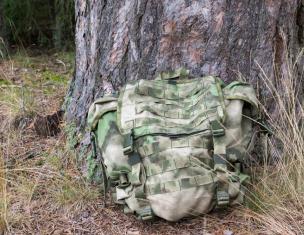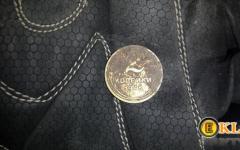Every second knows about the benefits of Tar soap. But many bypass him, defiantly wrinkling their nose from a sharp and somewhat bad smell. Perhaps store-bought tar soap is not as useful as we would like, so the ideal option is to cook it at home, choosing the ingredients yourself.
Birch tar has long been famous medicinal properties, which are excellent when using soap self made, which can help with various skin diseases, heals small cracks, wounds, cuts, nail fungus, acne, irritated skin, pustules on the face and back, age-related acne. And this is not a complete list. Let's prepare soap with tar in the form of a chocolate cake in a cold way. Let the aroma not scare you, it is not absorbed by the skin, it only gives its beneficial properties.
Ingredients:
- Purified coconut oil 31% - 385 g.
- Palm oil 40% - 500 g.
- Olive oil 17.5% - 220 g.
- Castor oil 11.5% - 150 g.
- Natural birch tar 5% - 50 g
- Distilled water.
- Caustic soda.
- Saucepan made of stainless steel or refractory glass for 2-3 liters.
- Capacity for alkaline solution for 500-600 ml.
- 2 spoons.
- 1 immersion blender.
- Soap mold (square box lined with parchment 20x20cm).
- Thermometer up to 100 degrees.
- Scales.
- Latex gloves for hand protection.
Next, you need to calculate in any alkali calculator the required amount of sodium hydroxide (caustic soda, alkali) and water. Be sure to carefully check all the calculations, comparing not only the weight of each oil separately, but also the total total. You can take a different amount of original oils, add existing ones or delete missing ones. The recipe does not indicate the amount of alkali, because. you need to calculate every gram and there should be no errors here.
It is important to correctly enter the data into the alkali calculator and carefully weigh the ingredients. Pharmacy scales will help to accurately determine the weight.
We also enter into the calculator the amount of water 33% by weight of the oils and “overfat before the bath” 7-10% - these are oils that will not be saponified and will remain untouched. Smaller percentage for oily skin and larger for dry. Further, when all the ingredients are weighed and the calculations are made, we put the pure weighed water into the freezer in a container made of refractory glass or stainless steel. Let it cool well and slightly freeze.

At this time, put all the oils, including overfat, in a water bath, stir until all solid lumps are completely dissolved. The temperature must be within 45°. You can heat the oil in the microwave or turn off the oven.


Make sure the oils don't overheat.


At this time, all solid oils have melted, we take water out of the freezer, put it in a bowl with ice and pour alkali in a thin stream, while continuously stirring with a stainless steel spatula. Stirring is required until all crystals are completely dissolved. At first the solution will become cloudy, then it will become transparent. Alkali tends to heat up in water and, if the latter is not cold enough, it will boil, so stock up on ice. Cool down to 45°, about the same temperature as the oil.

The oils and the alkaline solution must be at the same temperature, a difference of 4-5° is acceptable. We connect.

For a few seconds, the mixture is mixed with a spoon, then an immersion blender is used. The mixer does not fit, it saturates the mass with air bubbles, which are useless in soap.

The soap mass is brought to the state of thick whipped sour cream. If you scoop it up with a spoon and put it on top, the mass will not sink, but will hold on for some time. This phenomenon in soap making is called "trace".


Next, we divide the future soap into 2 parts. We will leave one snow-white, add tar to the other.

Both masses are alternately laid out in layers in the prepared form. You will have to work quickly, because. the white part hardens very quickly and after 5 minutes it will be quite difficult to form. Tap the filled form on the table so that air bubbles come out, and the mass penetrates into all corners. Draw arbitrary lines on top with a wooden stick. For beauty.

The form should be covered with a film and wrapped in a towel, then put in a warm turned off oven. Temperature 50°. Let the soap stand in this state for several hours or overnight. In the morning, take it out, separate it from the parchment and cut into the necessary pieces. Remember to wear gloves, cold soap is not ready yet. Wrap in paper and leave to ripen for a month and a half.
Soap is used for various purposes:
- For washing with acne, pimples, lichen, pustules. Mainly for oily and problematic skin. For dry skin, be sure to use a cream after cleansing.
- For washing hair.
- Fungal diseases.
- Burns, wounds, cuts, bites of animals and insects.
- Cracks in the heels.
- Pests on plants.
- For bathing domestic dogs and cats.
- Intimate hygiene of women.
- For toddlers and babies.
By making tar soap useful for the skin from scratch, you can be sure of its quality. It becomes possible to use one of the recipes, which allows you to independently add some additives to the composition in order to level the pungent odor.
The classic composition of tar soap is based on the use of birch tar. This natural substance has a rich structural formula, which includes the following elements:
- xylene;
- creosols;
- benzene;
- phenol;
- resinous substances;
- toluene;
- phytoncides;
- organic acids.
The concentration of tar in soap is approximately 10%. The use of tar soap is due to its antiseptic, anti-inflammatory properties. Beneficial if the following skin problems are identified:
- psoriasis;
- seborrhea;
- lichen;
- eczema;
- dandruff;
- acne;
- neurodermatitis.
hot way
There are recipes that are more complex for tar soap, for example, a variation of its cooking from several components (the amount is indicated in grams):
- a mixture of oils: olive - 150, palm - 120, cocoa - 100, coconut - 80, grape seed - 50;
- alkali - 72;
- tar - 40;
- overfat (shea butter) - 30;
- water - 165.
The mixture should be boiled for 20 minutes.
To wash your hair in order to get rid of dandruff and strengthen your hair, shampoo tar soap is prepared in the following composition (the number of components is indicated in grams):
- oils: coconut - 150, castor - 120, olive - 120, sunflower - 60;
- cooking oil - 160;
- alkali - 105;
- tar - 10;
- citric acid - 7;
- decoction of nettle with St. John's wort - 160.
Boiled for 20 minutes. If you wash your hair with this soap twice a week, after a while they will acquire a healthy look. It is recommended to use foam, which is gently rubbed into the scalp, distributed over the curls, and then washed off. The smell of tar disappears quickly if added to the rinse water Apple vinegar in a ratio of 1:4. To soften the strands after washing, they are treated with special ones. After a month of such a therapeutic head wash, it is advisable to take a two-month break. Not recommended for dry seborrhea. To use tar soap to prevent hair problems, it is enough to apply it once a week.
Tar soap is deservedly considered one of the the best means from various skin diseases. It copes with problems such as acne, acne, eczema, psoriasis. The beneficial effect of this soap on the skin has long been known, it also promotes the healing of wounds and scratches and is indispensable for their treatment, since birch tar, which is part of it, has a very strong disinfectant and antiseptic property. Traditionally, tar soap is recommended for caring for problematic skin however, homemade tar soap from scratch can be used to care for any type of skin. It improves blood supply to tissues, stimulates the regeneration of the epidermis, has a tonic effect on the skin without overdrying it.
It is possible to list all the advantages of tar soap for a very long time, so I recommend that those who are fond of home soap making definitely try it. Of course, not everyone tolerates the specific smell of tar, and I strongly recommend cooking it in the spring-summer-autumn period, when it is possible to leave it to mature on the balcony. During cooking and ripening, the smell is very strong! And nothing is interrupted! The addition of essential oils in this case is only enriching properties.
Birch tar can be purchased at a pharmacy, dosages for soap - 2-3% - for preventive properties and up to 10% for medicinal purposes.
So the recipe:
Babassu oil - 100g. (15.38%)
Grape seed oil - 150g. (23.08%)
Coconut oil - 120g. (18.46%)
Olive oil - 280g. (43.08%)
Total - 650g. oils
Birch tar - 1 vial - 40 ml. (it turns out a little more than 6%)
Overfat - 7%
Water -33% - 214.5g.
NaOH - 89.65g.
We weigh all the oils and send them to melt in a water bath. We will prepare the soap in a cold way, so we will immediately select the shape.
I wanted to play around and make the soap more fun, so there is also a jug and a separate spoon for a layer not stained with tar.


We prepare an alkaline solution, melt the oils. More and.
Pour the alkaline solution into the oil, bring to a light trace. About one third of the mixture is poured into a separate bowl, we do not touch it. Add tar to the main mass, mix. The scent is amazing!!!


In the prepared form, randomly lay out the dark and light parts of our soap. Each color has its own spoon. It turns out something like this ... When the whole mass is laid out, you can lightly move the stick over the surface without deepening it into the soapy mass, then you get a prettier top.


We wrap the form in a towel and leave it in a warm place to go through the gel stage. The cooled soap is cut into pieces and sent to a cool, well-ventilated place to mature for at least 4, and preferably 6 weeks.


As I said, the soap turns out to be very “fragrant”, so it’s better to prescribe it on the balcony for the ripening time! Just keep it out of the sun and rain.
And yet, from personal experience I noticed that tar soap noticeably improves the condition of the skin, firstly, not immediately, and secondly, only with systematic use. That is, if I wash my face with it at least once or twice a week, then I don’t see anything like pimples, but I just have to be lazy and forget about my tar ritual for a couple of weeks, as they immediately, right there!
Thanks for stopping by, and happy soapmaking!
(Visited 7 950 times, 1 visits today)
Tar soap will cleanse the skin, normalize sebaceous secretion, improve blood circulation, accelerate hair growth, and increase their volume. It successfully acts against dandruff and excess fat in seborrhea, cleanses the skin and hair well. In addition, it reanimates the structure of the hair, boosts growth, improves their condition.
Tar soap is also used to treat inflammatory processes on the skin of the face and body.
Tar has a very bad smell, however, copes well with dandruff, seborrhea, hair loss and oily hair, so the popularity of birch tar only intensifies over time. Also tar soap is one of better ways get rid of lice.
Tar soap can be bought at a pharmacy, from soap makers, or you can learn how to make soap yourself. Such homemade soap will be really healing not only due to tar, but also due to the absence of SLS and other "harmful things".
The percentage of tar in the soap: 1-10%. In therapeutic soap for complex diseases of the scalp from 5 to 10%, in soap for dandruff and soap for prevention - 1-3%. If you have fair hair, we recommend adding no more than 2% to the soap.
How to add tar to soap
Tar in soap from scratch is introduced into a dense trace if the soap is prepared in a cold way. In hot soap, tar is introduced after the bath, along with essential oils and overfat in the cooled soap.
The effect of tar on the skin and hair
- The tar contains a huge number of different substances that give it antiseptic, anti-inflammatory, drying and antipruritic properties.
- Tar treats skin diseases: dandruff, fungal infections, erysipelas, psoriasis, psoriasis, seborrheic dermatitis, eczema, folliculitis, pediculosis, scabies, vitiligo, trophic non-healing ulcers, bedsores and others. Various wounds, skin burns with birch tar can also be cured.
- Tar improves cell regeneration, increases blood flow in skin tissues, promotes its renewal. The main positive property of birch tar, which acts on the hair, is irritation of the scalp. Due to the irritating effect, blood circulation increases, the hair root follicles receive extra food, active growth of curls begins. It has been proven that the natural product has an "irritating" effect on the "sleeping" hair follicles, which, under the influence of birch tar, "awake" and become more active, which accordingly affects the density of the hair.
- Even with the external use of tar, it has an effect on general well-being: patients note a decrease in irritability and improved sleep, a decrease in skin itching, and an anesthetic effect is also observed.
Tar soap from scratch recipe
We offer you a simple recipe for tar hair soap, which contains few ingredients and is ideal for beginner soap makers. In addition, according to reviews, this is the most successful shampoo soap recipe for hair, which suits almost everyone. Of course, with this soap you can wash not only your head, but also your body, especially if you have skin rashes.
- Castor oil - 105 grams (15%)
Coconut oil T pl \u003d 24.4 C - 210 grams (30%)
Sunflower oil - 385 grams (55%) - Alkali NaOH - 106.59 grams \u003d 98.6 (for saponification of oils, taking into account overfat 5%) + 7.99 (for neutralization citric acid)
Water - 196.0 grams (28%) - Citric acid 14 gr (2%)
Citric acid - gives conditioning properties to hair soap, softening properties, and also helps to facilitate combing, which is important when washing hair. When adding citric acid to soap, it should be borne in mind that, like any other acid, it neutralizes alkali, and therefore, it is necessary to calculate its additional amount. Additional amount of NaOH alkali during preparation hard soap- 0.6 g per 1 g. citric acid. An additional amount of KOH alkali in the preparation of soft soap is 0.87 g per 1 g. citric acid. The usual dosage of citric acid in soap is 1-3%.
We cook tar soap in a cold way

How to use tar hair soap
When treating hair and scalp, do not neglect the advice to wash your hair with warm water, not hot. Otherwise, greasy plaque will remain on the hair. It is more convenient to lather your head not with a bar of soap, but lather it first in your hands, or dissolve it in water, and only then apply the foam to your hair. Do not wash off the foam immediately, hold for 10 minutes. Rinse with slightly warm water.
Do not forget about the drying effect of tar soap, do not use it often and constantly.
IMPORTANT! Blonde hair when using tar soap may darken.
Of course, not everyone likes the smell of tar, but it is easy to get rid of it by simply storing soap in a closed soap dish. In addition, after washing off the soap from the skin, the smell does not remain at all. Many who categorically cannot stand the smell of tar put up with this due to the effect that it brings after application.
If you have not previously used soap to wash your hair, then it will take time to rebuild - about a month. During this period, the hair may look dull, unkempt, as industrial shampoos contain silicones that visually make our hair healthy, but are actually covered with a film that works wonders: the hair shines and does not get tangled. A serious disadvantage of this film is that it prevents oxygen, moisture, and nutrients from entering the cells. As a result, the hair becomes thinner, falls out, becomes brittle, and breaks. If you are tired of fighting dandruff, hair loss, oily hair and come to the conclusion that you wash your hair daily, and by the evening it is still oily, then you should switch to natural remedies for washing hair or shampoos.
How to improve the recipe for tar hair soap?
If you do not have any base oil from tar soap recipe, or you are experimenting with the base composition, trying to find the perfect recipe for your hair, then you can replace some oil with another suitable for shampoo soap. Be sure to recalculate the weight of the lye on the soap calculator when making changes to the recipe.
Grape seeds (up to 20%) suitable for both oily and dry hair; regulates sebum secretion, tones hair follicles; protects against breakage and restores the structure of the hair, moisturizes; great option for a snack
Mustard (up to 20%), well suited for this type of soap, has a stimulating effect on hair growth, prevents hair loss
Jojoba oil (up to 10%). Helps with dry scalp and hair loss ideal for use in overweight. May leave residue.
Coconut (from 15 to 50%), gives a good foam, perfectly cleanses the hair. For dry hair, it is better to take a smaller percentage. coconut oil 15 — 20%.
Cocoa butter (up to 5%), with a higher percentage of input, it can leave a coating and a feeling that the hair is not washed. It gives the soap good care qualities. Burdock oil helps to strengthen the hair roots and restore their structure, it is especially good to use in case of hair loss, it is perfectly washed off.
Hemp (up to 15%)- excellent oil for shampoo soap, suitable for dry and sensitive skin head, softens.
Castor oil (up to 20%). Good foam stabilizing oil. It also perfectly nourishes and softens dry hair, has a good effect on the scalp.
Palm oil (up to 20%)- makes the hair a little heavier, you should not add it to the soap.
Sunflower – up to 100%. Rinses well, does not weigh hair down; good for oily hair; in general, it is well suited for shampoo soap and has a minus only in a short shelf life
What oils should not be added?
It is not advisable to add palm oil, as it can leave a residue on the hair. It is believed that olive oil turns hair into icicles. In fact, there are no strict prohibitions on this or that oil. You can experiment and select oils that suit you individually. And there were examples on our forum of soap makers, when hair soap made with 100% olive oil was ideal.
Additives in tar hair soap from scratch
Silk from 0.5 to 3%.(silkworm cocoons, tops, silk thread) - silk proteins will take care of the scalp and hair. Added to alkaline solution. Silk in shampoo soap is used to make hair easier to comb and add shine to it.
Dry mustard powder (up to 2%)- gives shine to hair, excessive production of fat normalizes, enhances growth (strands grow by 2–4 cm per month), the hairstyle will gain volume, hair roots are strengthened, and hair loss stops. Hair will look cleaner longer.
Salt (up to 10%).- used to strengthen hair, and also acts as a preservative. In shampoo soap, the recommended input is up to 10%. Salt also has a drying effect. Owners of dry hair are advised to use with caution.
Honey and bee products- enrich soap with its useful properties. Add before laying out in forms. We talked about the properties of honey in the article honey hair masks.
Egg added to the cooling soap - only the yolk squeezed out of the films. When cooking, cholesterol is added to the trail, with HS - along with overfat, or chilled. 1 yolk for 400-500 grams of oils. The benefits of adding yolk to soap are doubtful, as soap is designed to cleanse, remove bacteria and fungi. It is better to use the yolks as a hair mask or natural shampoo.
Zinc oxide (up to 3%). Zinc oxide acts as an antiseptic, eliminates local manifestations of inflammation and irritation, forms a protective coating on the skin, which reduces the impact of irritating factors on it, astringent, powerful antimicrobial, optimizes sebum secretion, dries.
Lactic acid (1-3%). when added to an alkaline solution, it forms sodium lactate in the finished solid soap, and potassium lactate in the soft soap. Sodium lactate softens the hair and scalp, while potassium lactate is able to moisturize and retain moisture in the hair.
Sodium lactate can also be bought ready-made from the store. Lactic acid, as well as citric acid, neutralizes alkali, therefore, it requires the introduction of an additional amount.
Additional alkali for 1g. 80% lactic acid - 0.36g. NaOH for solid soap or 0.5g. KOH for soft.
Sulfur (up to 5%) The precipitated sulfur will help the hair become healthy and shiny due to its direct participation in the synthesis of the previously mentioned collagen and keratin. Sulfur will help with excessive oily hair, and in the fight against dandruff, if the cause of this problem is a fungus.
Hair soap is usually prepared on decoctions of herbs, caring for hair and scalp: burdock root, calamus, dandelion, chamomile, violet, yarrow, etc. As a liquid, you can take beer, wine or cognac.
We recommend not to overload tar soap active additives, since tar itself is a very powerful remedy. Tar soap is used more often if there are any problems with the scalp or hair and is not suitable for daily care. Therefore, silk, honey, eggs, milk and other additives are best used in a separate soap for everyday hair washing.
Hair soap recipes and reviews from scratch
We are waiting for your feedback on the use of tar soap for hair. Thank you for your attention!
Hello friends!
Today, according to the plan, we have liquid tar soap!
Why liquid?
Oh, it's simple!
I have an extremely sensitive nose 🙂
It's no secret that bar tar soap, if it gets into the bathroom, it will fill it all with its smell, and even hang a little in the corridor.
Things are better with liquid tar soap - I closed the bottle, and the smell is under lock and key! And from the hands it disappears quickly!
Why did I even start making tar soap?
Tar soap one of best products problem skin care.
I also read that this is one of the best remedies for dandruff, but I haven’t tried it myself.
In any case, even with half of the declared qualities, the thing is excellent!
And I even have a couple of recipes for hard tar soap on my blog:
And everything in it is good, but this smell is everywhere! 🙂 But there is no such problem with liquid soap 🙂 I closed it and everything is ok.
You can use any potassium paste recipe you like to make this soap.
Since potassium paste always turns out to be too much, I took the one that was on hand.
Tar - bought in a pharmacy.
Potassium Paste Recipe:
By the way, a good recipe - a pleasant foam and nothing more.
And it looks just lovely! Look how beautiful! (Probably only soap makers will understand :))))
Recipe for tar liquid soap:
Let me remind you that for 100 g of soap you can simply replace % with grams.
So, we take potassium paste
Adding glycerin
We heat the paste with glycerin until dissolved in a water bath or in a microwave.
The mass should become homogeneous, fluid.
Now pour this paste in a thin stream into hot water and stir.
Everything should disperse without lumps.
Now it's up to the tar. Pour it into the soapy mass.
That's where the preservative is. I prefer to preserve liquid soap, although tar, it seems to me, can preserve anyone you want :))))
Pour into a bottle
That's all! Ready! Close the lid - and into the bathroom. Can be poured into a dispenser, or just in a bottle.
For beauty and photos I found a jar 🙂
Do you like tar soap??
You may be interested in:
- Makeup remover wet wipes…
- Do-it-yourself warming foot balm (recipe and ...









